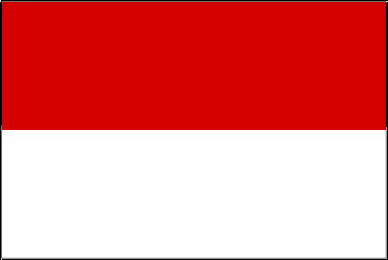latest picture: July 7, 2007
- click a picture to see details
|
- More websites from Indonesia and Timor-Leste:
|
-
- On November 21st, 2006, we left the Island of Borneo
after half a year, where we overhauled completely
our car and visited the Malaysian provinces of Sarawak
and Sabah and two new countries – Brunei (# 154) and in Kalimantan the "begin" of
Indonesia (# 155) –, driving a total of 3'258 miles. Two days later, we arrived on a
domestic ferry in Jakarta, the capital of Indonesia, a mega-city of about 17 million
people on the island of Java. Then, a whole range of more Indonesian islands followed:
Sumatra to the West and Bali, Lombok, Sumbawa, Rinca with the Komodo Dragons, Flores,
Sumba and Timor to the East. In-between we explored the 156th country – Timor-Leste –, before our Indonesian roundtrip continued
in Sulawesi and ended finally in Kalimantan on the Island of Borneo.
|
-
-
-
- This is the continuation of
- (13. bis 27. Juni 2007)
|
-
-
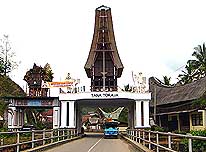
|
-
-
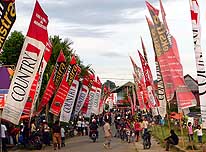
|
-
|
- 16
The entrance gate to Tana Toraja near
- Mebali – the Toraja land – is greeting us
- with the replica of a traditional Toraja
- house. From this very moment, this
- fascinating unique architecture is
- accompanying us continuously
|
- 17
The streets in Rantepao are festively
- flagged for the “Motorace 2007”. The
- most represented is the publicity for
- cigarettes – „Country, the flavor of
- adventure“. Indonesia is a country
- where practically everybody smokes!
|
-
-
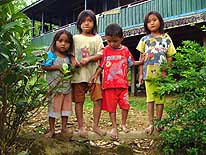
|
-
-
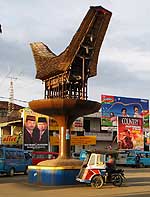
|
-
-
-
-
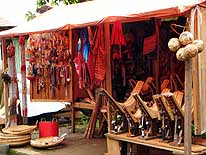
|
- 18
As everywhere in Indonesia,
- these children from Tana Toraja
- greet us also with „Hello Mister!“
|
- 19
The roundabout in the
- heart of Rantepao shows also
- the symbol of Tana Toraja –
- the traditional Tongkonan house
|
- 20
This souvenir shop in Rantepao
- is selling – amidst other things –
- traditional miniature Tongkonan
|
-
-
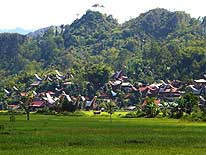
|
-
-
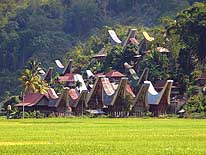
|
-
-
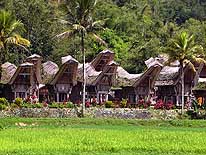
|
- 21
The striking architecture of the
- Tana Toraja villages with the towering
- roofs of its Tongkonan stick out
- everywhere in the peaceful highland .....
|
- 22
..... is it with modern corrugated
- iron roofs, as here near Bori .....
|
- 23
..... or with traditional roofs of
- bamboo and leaves – as in Ke’te Kesu
|
-
-
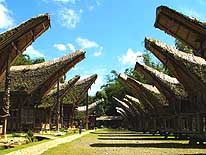
|
-
-
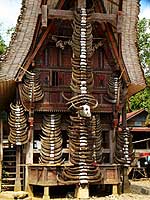
|
-
-
-
-
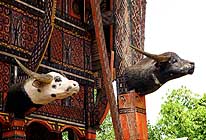
|
- 24
Traditional Tongkonan houses
- always look north and face a line
- of rice barns – here in Ke’te Kesu
|
- 25
The bigger the number of
- buffalo horns decorating the front
- of a house, the bigger the wealth of
- the family or clan. They date from
- earlier ceremonies – here in Palawa
|
- 26
Mostly only one buffalo head is
- decorating the elaborately adorned
- Tongkonan houses. In Palawa
- there are even two
|
-
-
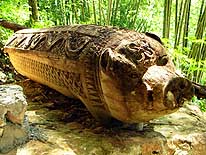
|
-
-
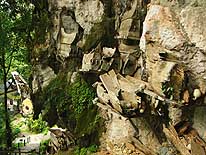
|
-
-
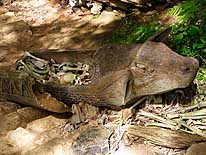
|
- 27
Richly carved coffins contain the
- bones of the dead. This one in
- Ke’te Kesu has the shape of a
- pig and is carved with snake motifs
|
- 28
Most of the coffins hanging on
- the steep cliff in Ke’te Kesu are rotten.
- Now and then a skull is peeping out
|
- 29
This open coffin in the shape of
- a cow reveals the bleached
- bones of the deceased
|
-
-
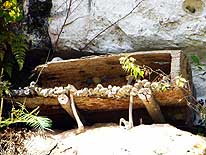
|
-
-
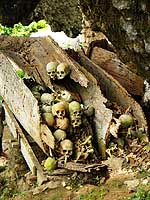
|
-
-
-
-
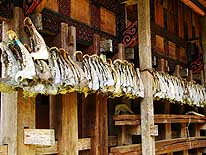
|
- 30
Piles of bones are hanging out
- from a wooden coffin in Marante .....
|
- 31
..... and dozens of
- skulls in Ke’te Kesu
|
- 32
Teeth of slaughtered buffalos
- are hanging in a line at a Tongkonan
- house in Ke’te Kesu
|
-
-
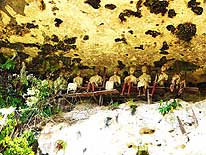
|
-
-
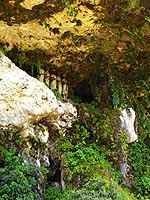
|
-
-
-
-
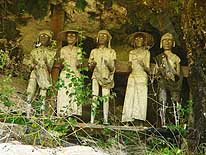
|
- 33
„Tau Tau’s“ are life-sized carved
- wooden effigies of the dead. They are
- placed on balconies outside cave
- graves, as here in Marante .....
|
- 34
..... here underneath an
- overhanging cliff in Marante .....
|
- 35
..... and again in Marante
- on a balcony
|
-
-
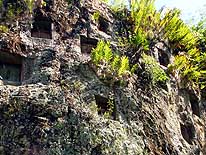
|
-
-
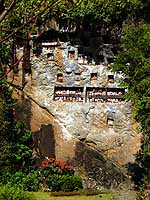
|
-
-
-
-
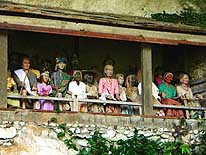
|
- 36
The cave builders were traditionally
- paid in buffalos for their hollowed out caves.
- Although the exterior of a cave grave looks
- small, the interior is large enough to “shelter”
- an entire family. This one is in Lemo
|
- 37
We find the most impressive
- „Tau Tau’s“ (effigies of the dead)
- in Lemo. They are several
- balconies on a vertical cliff
|
- 38
In Londa, they are protecting
- a cave. In their dresses and mimic
- they nearly take shape again!
|
-
-
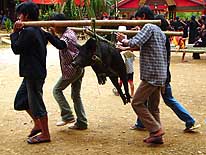
|
-
-
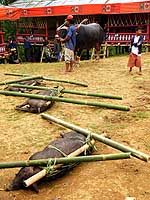
|
-
-
-
-
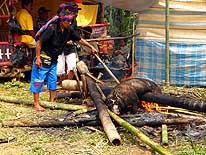
|
- Traditional funeral ceremony in Nonongan:
|
- 39
Pigs trussed on bamboo
- poles are carried in alive .....
|
- 40
..... put on the ground .....
|
- 41
..... until they are slaughtered
- and grilled on the fire
|
-
-
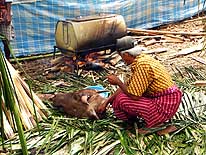
|
-
-
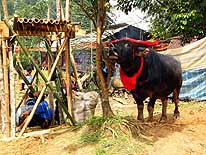
|
-
-
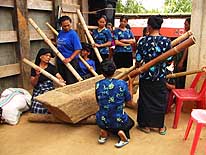
|
- Traditional funeral ceremony in Nonongan:
|
- 42
From this cow only the head
- remains, one part cooks
- already in the pot
|
- 43
The horns of this buffalo are
- already adorned with ribbons for
- the sacrifice. The number of buffaloes
- sacrificed depends on the importance,
- age and status of the deceased. In
- Nonongan there were nine animals
|
- 44
Women beat with thick
- bamboo poles on a wooden
- trough what creates a
- sound similar to drumming
|
-
-
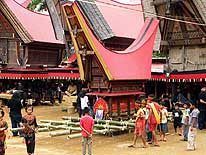
|
-
-
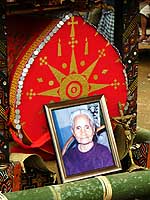
|
-
-
-
-
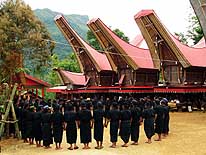
|
- Traditional funeral ceremony in Nonongan:
|
- 45
The coffin, decorated in gold and
- red, is placed on a stretcher made
- of bamboo on the village square
|
- 46
The picture of the dead is
- leaning against the coffin. The
- Toraja generally have two funerals,
- one immediately after death and a
- second later once the funds
- are ready and the complicated
- preparations are finished
|
- 47
Men and women dressed in black
- sarongs are singing and dancing the
- traditional „Mabadong“. Like the animal
- sacrifices, it belongs to each traditional
- funeral. It symbolizes the cycle of life
- and the life story of the deceased and
- also bits farewell to the soul of the dead
|
-
-
-
-
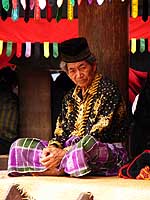
|
-
-
-
-
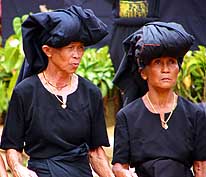
|
-
-
-
-
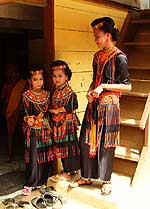
|
- Traditional funeral ceremony in Nonongan:
|
- 48
This smartly dressed man
- belongs to the mournful guests
|
- 49
These two women stand shoulder to
- shoulder, performing the traditional dance
|
- 50
Young girls wear their
- traditional beaded funeral dress
|
-
-

|
-
-
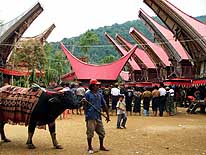
|
-
-
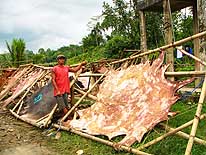
|
- Traditional funeral ceremony in Nonongan:
|
- 53
Later, the skins of the
- slaughtered buffaloes will be
- mounted on wooden frame to dry,
- like here on the way to Palawa
|
- 51
Family members are gathering around
- the coffin, a catholic priest is speaking to
- the mourners and blessing the coffin. The
- missionaries never were successful to com-
- pletely ban the traditional beliefs of the Toraja
|
- 52
The first buffalo appears to
- be sacrificed. This is the
- moment we leave .....
|
-
-
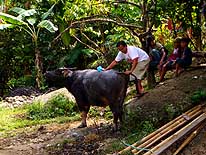
|
-
-
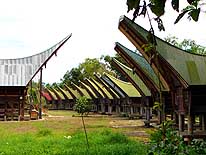
|
-
-
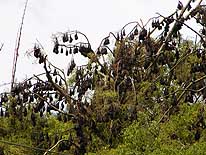
|
- 54
Buffalos are often the whole wealth
- of a family. Therefore they are looked
- after carefully: scrubbed and washed, the
- most intensive before funeral ceremonies
|
- 55
The loveliest series of rice
- barns are found in Nanggala. The
- traditional Tongkonan house
- is under construction .....
|
- 56
..... but we enjoy the many bats
- hanging on the trees at the
- entrance of the village
|
-
-
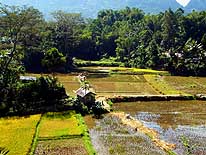
|
-
-
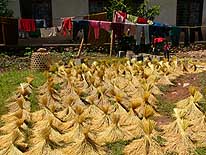
|
-
-
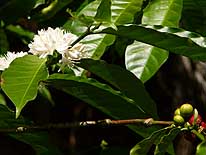
|
- 57
Small valleys of rice paddies
- give the landscape a peaceful look.
- They are wide spread in Tana
- Toraja. This one is near Lemo
|
- 58
It is rice harvest time. Like
- here in Marante, rice stalks are
- bundled and laid out to dry
|
- 59
The altitude of Tana Toraja – here in
- Lemo – is favorable for coffee growing. It
- is interesting that this plant can have fruits
- and blooms at the same time. The delicate
- scent of the white blossom is everywhere
|
-
-
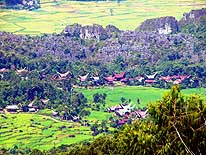
|
-
-
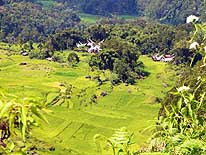
|
-
-
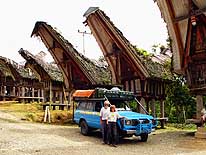
|
- 60
|
- 61
|
- 62
We pose for a picture in Palawa
|
- On the way from Palawa via Deri to Batutumonga, the panoramic views of
- Rantepao and the Sa’dan valley on an altitude of 2’600 ft. are outstanding
|
-
-
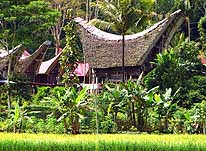
|
-
-
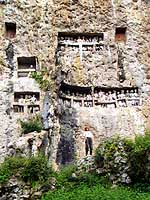
|
-
-
-
-
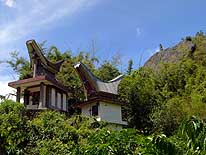
|
- 63
The impressive, striking and
- boat-shaped Toraja houses are
- always worth a photo stop
|
- 64
Liliana in front of the biggest
- concentration of „Tau Tau’s“ – effigies
- of the dead –at the Kings Graves in
- Tampangallo near Suaya. There are
- 40, though not in a good condition
- and slowly deteriorating
|
- 65
Graves in Toraja land are not
- always hollowed in cliffs. In the
- hinterland, they often are also
- built on lofty hills like here along
- the Trans-Sulawesi-Road
|
-
-

|
-
-
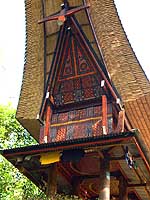
|
-
-
- Continuation of
- Sulawesi's South:
- from July 9th to 14th, 2007
|
- 66
Wedding guests in their traditional
- outfit are on their way to a church
- in Rantepao
|
- 67
Before we wave good-bye to
- beautiful Toraja land, we discover one
- more delicately carved traditional
- house in the hinterland of Lomba
|
-
|
-
|
|
Continuation:
South
of Sulawesi
from July 9th
to 14th, 2007 |
|
|
- More websites from Indonesia and
Timor-Leste:
More websites from East Malaysia and
Brunei:
|
- Articles in newspapers about us in Indonesia:
- Article: "Tamu Istimewa: Neverending
Journey", Monthly Car Magazine "Jip", January 2007
- Article: "Toyota
FJ60 1982 World Travelers", Monthly Car Magazine "Jip", February
2007
- Article: "CHEESE
LAND CRUISER", Monthly Car Magazine "BBC Top Gear", February 2007
- Article: "22
Tahun Jelajahi 156 Negara", Daily Newspaper "Post
Metro Balikpapan", July 17, 2007
|
